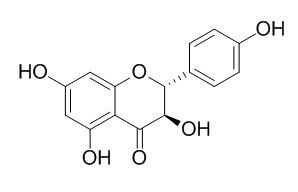Aromadendrin
Aromadendrin possesses anti-inflammatory, antioxidant, and anti-diabetic properties, it exhibits anti-inflammatory activity through the suppression of nuclear translocation of NF-κB and phosphorylation of JNK in LPS-stimulated RAW 264.7 macrophage cells. Aromadendrin treatment induces adipogenesis by increases in PPARγ2 expression, resulting in stimulation of glucose uptake and ameliorated insulin resistance, suggests that it may represent a potential therapeutic candidate for the management of type 2 DM. Aromadendrin has inhibitory activity on aldose reductase and the formation of advanced glycation end products.
Inquire / Order:
manager@chemfaces.com
Technical Inquiries:
service@chemfaces.com
Tel:
+86-27-84237783
Fax:
+86-27-84254680
Address:
1 Building, No. 83, CheCheng Rd., Wuhan Economic and Technological Development Zone, Wuhan, Hubei 430056, PRC
Providing storage is as stated on the product vial and the vial is kept tightly sealed, the product can be stored for up to
24 months(2-8C).
Wherever possible, you should prepare and use solutions on the same day. However, if you need to make up stock solutions in advance, we recommend that you store the solution as aliquots in tightly sealed vials at -20C. Generally, these will be useable for up to two weeks. Before use, and prior to opening the vial we recommend that you allow your product to equilibrate to room temperature for at least 1 hour.
Need more advice on solubility, usage and handling? Please email to: service@chemfaces.com
The packaging of the product may have turned upside down during transportation, resulting in the natural compounds adhering to the neck or cap of the vial. take the vial out of its packaging and gently shake to let the compounds fall to the bottom of the vial. for liquid products, centrifuge at 200-500 RPM to gather the liquid at the bottom of the vial. try to avoid loss or contamination during handling.
Int J Mol Med.2016, 37(2):501-8
Molecules.2022, 27(5):1675
J Agric Food Chem.2024, 72(15):8784-8797.
Bulletin of Health Research2016, 44(4):279-286
Nutrients.2018, 11(1):E17
Cytotechnology.2017, 69(5):765-773
J Hepatocell Carcinoma.2022, 9:327-341.
Agriculture2022, 12(12), 2173.
Molecules.2023, 28(18):6734.
Food Research International2016, 106-113
Related and Featured Products
Pharmacology. 2011;88(5-6):266-74.
Stimulation of glucose uptake and improvement of insulin resistance by aromadendrin.[Pubmed:
22056597]
Agents that stimulate glucose uptake and improve insulin resistance may be useful in the management of type 2 diabetes mellitus (DM). Thus, the aims of this study were to assess the effects of Aromadendrin, a flavonoid from Gleditsia sinensis Lam., on stimulation of glucose uptake and improvement of insulin resistance and to characterize the molecular mechanisms underlying these activities.
METHODS AND RESULTS:
Insulin-stimulated glucose uptake was measured in HepG2 cells and in differentiated 3T3-L1 adipocytes using 2-[N-(7-nitrobenz-2-oxa-1,3-diazol-4-yl)amino]-2-deoxy-D-glucose (2-NBDG), a fluorescent D-glucose analog. Expression of the peroxisome proliferator-activated receptor-γ2 (PPARγ2) and adipocyte-specific fatty acid binding protein (aP2) mRNAs and the PPARγ2 protein was analyzed in adipocytes using RT-PCR and immunoblotting, respectively. Insulin-stimulated protein kinase B (Akt/PKB) phosphorylation was measured in high glucose-induced, insulin-resistant HepG2 cells. Similar to 30 μmol/l rosiglitazone, treatment with 30 μmol/l Aromadendrin significantly stimulated insulin-sensitive glucose uptake in both HepG2 cells and 3T3-L1 adipocytes. Aromadendrin treatment also enhanced adipogenesis and caused increases in the expression of PPARγ2 and aP2 mRNAs and the PPARγ2 protein in differentiated 3T3-L1 adipocytes. In high glucose-induced, insulin-resistant HepG2 cells, Aromadendrin reversed the inhibition of Akt/PKB phosphorylation in response to insulin, which could be abrogated by pretreatment with LY294002, a phosphatidylinositol 3-kinase (PI3K) inhibitor. Aromadendrin treatment induced adipogenesis by increases in PPARγ2 expression, resulting in stimulation of glucose uptake and ameliorated insulin resistance.
CONCLUSIONS:
These findings suggest that Aromadendrin may represent a potential therapeutic candidate for the management of type 2 DM.
Food Sci. Biotechnol., 2011, 20(5):1283-8.
Inhibitory Activity of Aromadendrin from Prickly Pear (Opuntia ficus-indica) Root on Aldose Reductase and the Formation of Advanced Glycation End Products.[Reference:
WebLink]
Prickly pear (Opuntia ficus-indica) is a longdomesticated crop plant of arid and semiarid parts of the world.
METHODS AND RESULTS:
The efficacy of extracts of prickly pear root for managing diabetes and diabetes complications was evaluated using a variety of in vitro bioassays. The ethyl acetate-soluble fraction was most effective in the prevention of diabetes and its complications via the inhibition of rat lens aldose reductase activity, the formation of advanced glycation end products, and α-glucosidase activity.
CONCLUSIONS:
MS and NMR were used to identify the bioactive compound from the ethyl acetate-soluble fraction as 3,5,7,4′-tetrahydroxyflavanone (Aromadendrin).
Biomol Ther (Seoul). 2013 May 30;21(3):216-21.
Aromadendrin Inhibits Lipopolysaccharide-Induced Nuclear Translocation of NF-κB and Phosphorylation of JNK in RAW 264.7 Macrophage Cells.[Pubmed:
24265867]
Aromadendrin, a flavonol, has been reported to possess a variety of pharmacological activities such as anti-inflammatory, antioxidant, and anti-diabetic properties. However, the underlying mechanism by which Aromadendrin exerts its biological activity has not been extensively demonstrated. The objective of this study is to elucidate the anti-inflammatory mechanism of aromadedrin in lipopolysaccharide (LPS)-stimulated RAW 264.7 macrophage cells.
METHODS AND RESULTS:
Aromadendrin significantly suppressed LPS-induced excessive production of pro-inflammatory mediators such as nitric oxide (NO) and PGE2. In accordance, Aromadendrin attenuated LPSinduced overexpression iNOS and COX-2. In addition, Aromadendrin significantly suppressed LPS-induced degradation of IκB, which sequesters NF-κB in cytoplasm, consequently inhibiting the nuclear translocation of pro-inflammatory transcription factor NF- κB. To elucidate the underlying signaling mechanism of anti-inflammatory activity of Aromadendrin, MAPK signaling pathway was examined. Aromadendrin significantly attenuated LPS-induced activation of JNK, but not ERK and p38, in a concentration-dependent manner.
CONCLUSIONS:
Taken together, the present study clearly demonstrates that Aromadendrin exhibits anti-inflammatory activity through the suppression of nuclear translocation of NF-κB and phosphorylation of JNK in LPS-stimulated RAW 264.7 macrophage cells.



